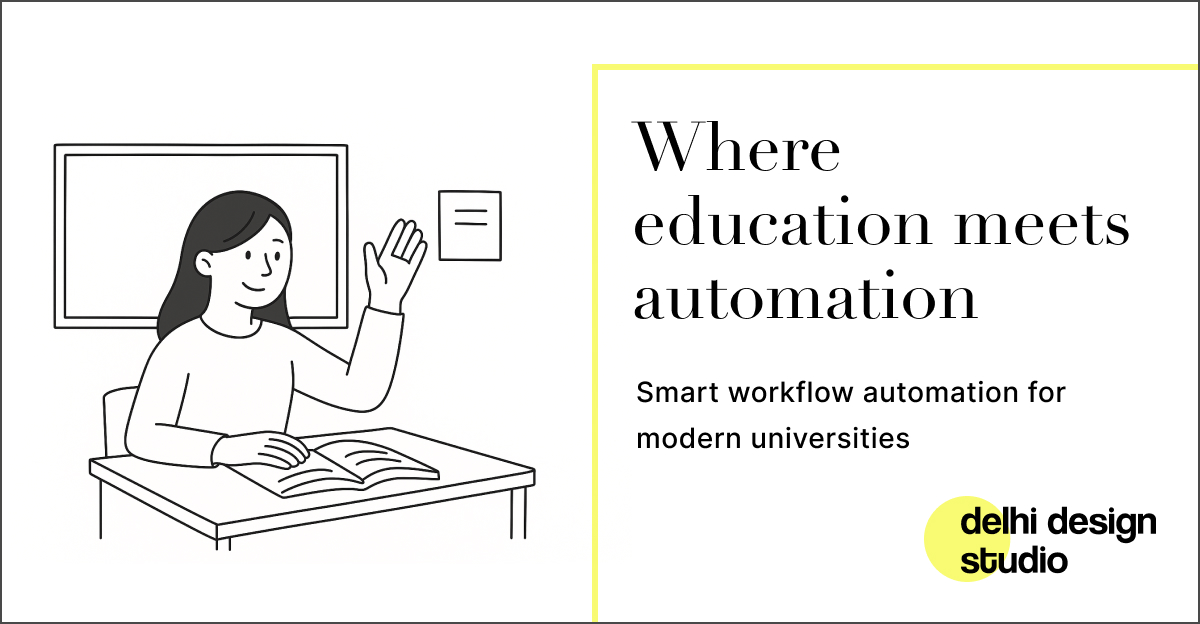
The Future of Higher Education is Automated
Unlock better productivity and student satisfaction with Delhi Design Studio’s design-first approach.
If you’ve ever dealt with universities, you know how deeply bureaucratic these institutions can be. The reason isn’t just rigid administrators—state regulations often require processes that cannot simply be “streamlined.” While we can’t change the law, what we can do is reduce the exhausting effects of bureaucracy: automate repetitive manual processes.
At Delhi Design Studio, we specialize in simplifying workflows through smart UI/UX design. Education technology (edtech), with its huge amounts of data, presented us with a challenge—but also with an opportunity to show how thoughtful workflow automation can transform the higher education industry.
Why is Edtech Growing So Fast?
The education industry has always been important, but the pandemic accelerated digital transformation like never before. In 2020, as distance learning became essential, edtech startups raised three times more funding compared to 2019.
The trend hasn’t slowed. Education startups are now attracting millions in investment each week. Companies like StudyFree, Educate Online, and Edukoya highlight the sector’s momentum. While many edtech startups focus on e-learning platforms, a growing segment tackles education workflow automation—a vital area for universities.
This need for automation existed even before the pandemic. Let’s explore the main challenges universities face that make workflow automation essential.
Challenges of Higher Education
1. Declining Student Enrollment
Universities worldwide struggle with enrollment numbers. According to Inside Higher Ed, many admissions officers were unable to fill their classes by the traditional May 1 deadline. Reasons include:
2. Marketization of Education
The concept of the “student-consumer” has become more prominent. Students expect quality service, while universities face budget cuts and stiff competition from private institutions. Balancing educational quality with financial sustainability is increasingly difficult.
3. New Education Formats
Universities now compete not only with each other but also with:
Traditional universities are often too slow to adapt because bureaucracy and lack of funds limit their ability to implement lifelong learning models.
Research from Formstack shows that 25% of education managers spend half their working hours on administrative tasks. While 62% of administrators already use workflow automation tools, the potential for further efficiency is massive.
What is Workflow Automation in Education?
Workflow automation replaces repetitive manual tasks with automated processes. For example:
By automating these processes, universities save time, money, and resources. One successful example is the University of Greenwich, which implemented automation and retained an estimated £3 million in revenue in just one academic year.
How to Start Education Workflow Automation
Universities are complex ecosystems, and not every process should—or can—be automated. The key is to focus strategically:
Key Considerations in Workflow Automation Design
1. Security
Universities have increasingly become targets of cyberattacks. For instance, a Spanish university was hit by ransomware in 2021 and had no choice but to pay. Protecting sensitive student data should be a top priority.
2. Compliance
Education is heavily regulated, and software must comply with local laws. For example, a solution built for the UK market can’t simply expand to Australia without adjustments to meet local education regulations.
3. User Experience
Many university systems—from websites to administrator dashboards—are notoriously difficult to use. Decision-makers often choose software based on features, while end-users struggle with poor design.
But research shows ease of use is almost twice as important as price when adopting automation tools. At Delhi Design Studio, we emphasize usability-driven design because intuitive systems not only improve satisfaction but also boost productivity.
Final Thoughts
Edtech is evolving rapidly, and workflow automation for universities is one of its most promising frontiers. A decade ago, students relied heavily on administrators. Today, digital systems allow students to manage most administrative requests independently.
This shift demonstrates how much time, effort, and cost savings automation brings to both staff and students. The next step is to make these systems truly user-friendly, secure, and compliant.
If you’re building an edtech SaaS product and want to deliver a superior user experience, our team at Delhi Design Studio is here to help.